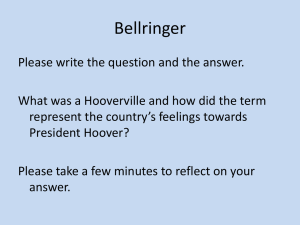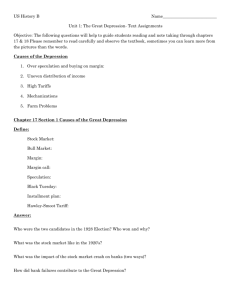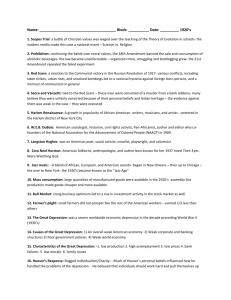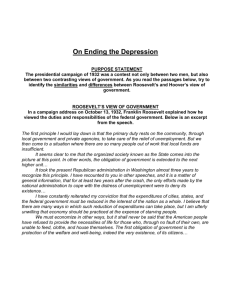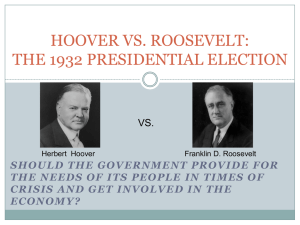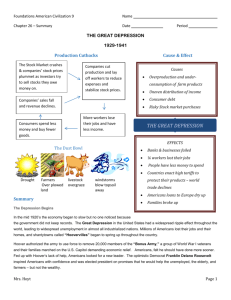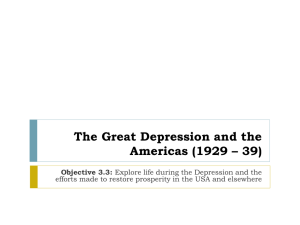week_12_hn_us
advertisement
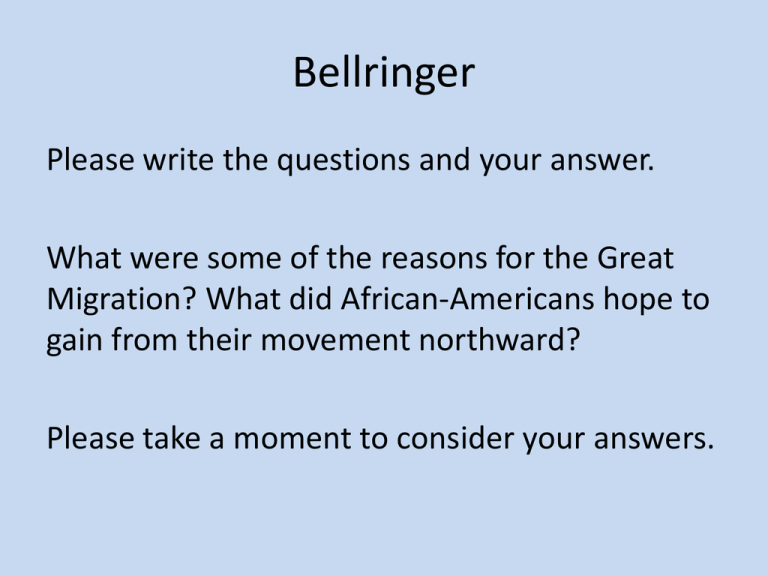
Bellringer Please write the questions and your answer. What were some of the reasons for the Great Migration? What did African-Americans hope to gain from their movement northward? Please take a moment to consider your answers. Key Harlem Renaissance Figures in Literature, Performing Arts, and the Fine Arts Using your phone or device, quickly look up what each of the following artists did, and list a work of theirs. 1. Langston Hughes 2. Paul Robeson 3. Louis Armstrong 4. Bessie Smith 5. Cab Calloway 6. James Weldon Johnson 7. Claude McKay Entertaining the Masses Quickly read page 661. How did the radio create a shared cultural experience for all Americans? In movies…Charlie Chaplin was the best known actor. And George Gershwin was the master of combining elements of Jazz with elements of classical orchestration. Lucky Lindy and other heroes Charles Lindbergh was the first to successfully complete a non-stop transatlantic flight. Let’s watch this quick video to see how he was greeted in 1927 in Europe. Amelia Earhart was the first woman to fly solo across the Atlantic as Lindbergh had done. Sports heroes such as Bobby Jones and Red Grange also became big names during this time. The Lost Generation F. Scott Fitzgerald (The Great Gatsby), Earnest Hemmingway (A Farewell To Arms, The Sun Also Rises), and other writers were referred to as the Lost Generation. These were poets, writers, and artists that came of age during the Great War, and in some cases were seen as damaged. The phrase comes from Hemmingway. Key Terms/ People to Know Section 1: gross national product, Herbert Hoover, buying on margin, Federal Reserve System, Black Tuesday Section 2: hobo, Great Depression, foreclosure, Hooverville, drought, Dust Bowl, Okie, Woody Guthrie Section 3: associative state, Hoover Dam, cooperative, Reconstruction Finance Corporation, Smoot-Hawley Tariff Act Bellringer Please write the question and the answer. What are two lessons you could take away from your experience during the stock market game yesterday? Please take a few minutes to reflect on your answer. The Good Times… • Economically, things were going great! – Vibrant, strong stock market with a lot of investment by average Americans – Profits soared – Very low national unemployment – Buying power of consumers had increased due to welfare capitalism and an abundance of credit. – Any doubt on behalf of the Federal Reserve is dismissed by business and banks …slow down... Some problems were just below the surface. – In 1929… • 5% of Americans controlled 70% of the wealth. • 95% controlled only 30% of the wealth. – Amount of money people saved (savings rate) declined during the 1920s. – An increase of “buying on margin,” or buying with the financial aid of stockbrokers, promoted very risky investing. • Margin calls protected brokers from losing money, leaving the investor exposed to the risk. – Decline in spending by consumers, leading to a large excess supply of goods …And All Come Crashing Down Chain of Events 1928 1929- September 3 Thursday, October 24 Friday, October 25 Monday, October 28 Black Tuesday, October 29 • Market indicators show 50% increase • High point in Market, 27% annual increase • Nervous investors begin to sell stocks, creating massive sell-off; some bankers join together to buy huge amount to stop a further sell-off in the next trading cycle • Normal trading resumes, some stocks show gains • Markets begin to fall once more • Complete panic as 16 million shares dumped and some $16 billion are lost in trading The Times Tells All “The crowds about the ticker tapes, like friends around the bedside of a stricken friend, reflected in their faces the tale the tape was telling. There were no smiles. There were no tears either. Just the camaraderie of fellowsufferers. Everybody wanted to tell his neighbor how much he had lost. Nobody wanted to listen. It was too repetitious a tale.” -New York Times, October 30, 1929 A Lifetime of Loss Anyone who bought stocks in mid-1929 and held onto them saw most of his or her adult life pass by before getting back to even. - Richard M. Salsman, American Economist “The recent collapse...has no significance…” With a partner, read pages 678-679. Describe how the crash effected: 1. 2. 3. 4. Individuals, particularly margin buyers Banks Businesses Other nations The Great Depression With a partner, answer the following questions from pages 681-685. This will be turned in. 1. What is a bank run, and how did it cause problems for many Americans? 2. What is foreclosure? 3. Look at the three graphs on page 681. What story do all three tell when looked at together? 4. What was the unemployment rate at the height of the Depression? 5. What was a Hooverville, and how did it get its name? 6. Why were many hoboes men? 7. Describe the Dust Bowl, and how did it make the Depression worse? 8. What were Okies, and how were they treated by many in other parts of the country? This Land Is Your Land Words and Music by Woody Guthrie Woody Guthrie This land is your land This land is my land From California to the New York island; From the red wood forest to the Gulf Stream waters This land was made for you and Me. As I was walking that ribbon of highway, I saw above me that endless skyway: I saw below me that golden valley: This land was made for you and me. I've roamed and rambled and I followed my footsteps To the sparkling sands of her diamond deserts; And all around me a voice was sounding: This land was made for you and me. When the sun came shining, and I was strolling, And the wheat fields waving and the dust clouds rolling, As the fog was lifting a voice was chanting: This land was made for you and me. As I went walking I saw a sign there And on the sign it said "No Trespassing." But on the other side it didn't say nothing, That side was made for you and me. In the shadow of the steeple I saw my people, By the relief office I seen my people; As they stood there hungry, I stood there asking Is this land made for you and me? Nobody living can ever stop me, As I go walking that freedom highway; Nobody living can ever make me turn back This land was made for you and me. The End of Hoover On your own, read through section 3 (pgs. 687-691) to answer the following questions. This will be turned in with your questions from yesterday. 1. How did Hoover’s idea of “rugged individualism” address personal responsibility? 2. What was the associative state, and how did the Hoover Dam represent that? 3. Why did Hoover think helping cooperatives would then help farmers? 4. What was the Reconstruction Finance Corporation and why was it created? 5. What was the effect of the Smoot-Hawley Tariff? 6. What was the Bonus Army, and how did Americans react to its treatment by Hoover and the government? Key Terms/People To Know Section 1: Franklin Delano Roosevelt, public works, fireside chat, Eleanor Roosevelt, Hundred Days, New Deal, subsidy, Huey P. Long, Father Charles Coughlin, Dr. Francis Townsend Section 2: Second New Deal, Social Security, John L. Lewis, CIO, sit-down strike, deficit, John Maynard Keynes The Election of 1932 1. Who was Franklin Delano Roosevelt? 2. What was his political experience? 3. What were two things that made him more likable than Hoover? 4. What was a “fireside chat,” and how did the chats help President Roosevelt? Stabilizing the Banks: Match the Term to the Correct Answer 1. Emergency Banking Act 2. Glass-Steagall Act 3. FDIC 4. SEC a) Insures the deposits of individuals b) Banks can be inspected by government c) Created the FDIC d) Enforces laws dealing with stocks and other securities The New Deal 1. What is the New Deal? 2. What are the three Rs used to describe the New Deal? 3. What was significant about the Hundred Days? The Second New Deal Marks a shift from direct payments as work relief to work for pay. Also see the creation of the Social Security Administration. Alphabet Soup: The New Deal With a partner, identify and describe the following acronyms and which “R” the program corresponded to. This will be turned in. • Civilian Conservation Corps (CCC) • Federal Emergency Relief Administration (FERA) • Public Works Administration (PWA) • Civil Works Administration (CWA) • Works Progress Administration (WPA) • Farm Security Administration (FSA) • Rural Electrification Administration (REA) • Federal Deposit Insurance Corporation (FDIC) • Securities and Exchange Commission (SEC) • National Labor Relations Board (NLRB) • Agricultural Adjustment Administration (AAA) • Tennessee Valley Authority (TVA) • National Industrial Recovery Act (NIRA) • National Recovery Administration (NRA) Bellringer Please write and answer the question. What New Deal programs did the following: 1. Enforce the NIRA 2. Pay farmers to grow fewer crops 3. Build dams for power and navigation in the Southeast 4. Paid Americans to work on conservation projects Please take a few minutes to reflect on your answers. Opponents of the New Deal For each of the following names, describe 1. Their background (what they do)? 2. Were they always against Roosevelt? 3. What particular issues did they have with Roosevelt’s policy? A. Huey P. Long B. Father Charles Coughlin C. Dr. Francis Townsend Courts and the New Deal Many New Deal Programs were challenged in the courts. Go through Sections 1 and 2 and find any mention of court cases against New Deal Programs. What did these cases do to the programs? Life in the Depression Skim through sections 3 and 4 and match the person or term. 1. 2. 3. 4. 5. 6. 7. 8. 9. 10. 11. 12. 13. swing Dorothea Lange Frances Perkins Mary McLeod-Bethune The Marx Brothers Father Charles Coughlin Snow White and the Seven Dwarfs Joe Louis Marian Anderson Joe DiMaggio, Lou Gehrig minimum wage Jesse Owens Orson Welles a) b) c) d) e) f) g) h) i) j) k) l) m) first full-length animated film. African-American boxer who fought against German in 1938 members of New York Yankees in 1930s the lowest wage an employer can pay a worker African-American singer who gave a private concert at the White House after having been denied billing at Constitution Hall. African-American track star, defeated Germans in 1936 Olympics in Berlin in front of Adolf Hitler popular form of dancing in the 1930s, usually done to fast jazz photographer famous for images of families in the Depression Famous actor, known for his version of War of the Worlds, which caused panic among the public on Halloween, 1938 Catholic priest who railed against the New Deal and FDR over the radio and gained a large following African-American woman who emphasized the need for education among the African-American communiity Secretary of Labor under FDR comedy troupe known for their witty humor in films and on stage

